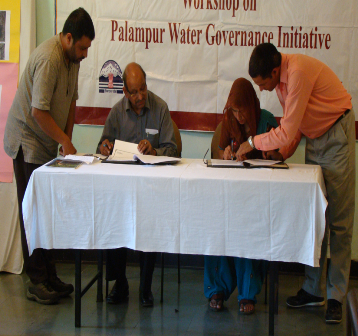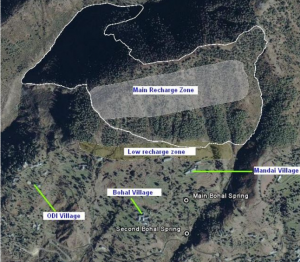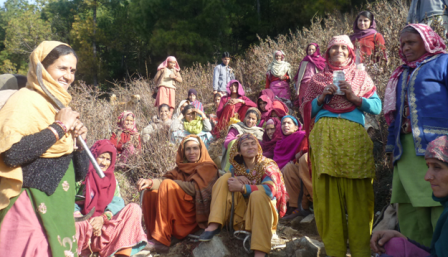Palampur: Figuring on the red zone about the likely impacts of climate change, water conflicts are already on the rise in Himachal and unless more interventions like Palampur Water Governance Initiative (PGWI) are not undertaken for conserving and recharging water sources, their sustainability is threatened in the face of global warming.
Talking about Germany’s GTZ backed PGWI pilot project, Farhad Vania, program manager said “ PGWI is an urban-rural engagement model for the sustainable supply of water and protection of catchment area.
The establishment of a commercial association between the rural and urban area not only incentivizes the rural communities of the catchment area for meeting the expanding water demands in urban areas but can also go a long way in reducing water conflicts.â€
While the fast expanding municipalities of Solan and Shimla are under tremendous pressure of maintaining drinking water supply, in terms of quality as well as quantity, the demand on source sustainability mounts in the face of climate change adaption and mitigation measures needed.
Advocating the PGWI model for establishing rural-urban as well as rural-rural linkages towards securing future water supply Vania cited the case of Palampur, which derives it water from four sources, Neugal River, Bagha Nala, groundwater and Bohal spring.
Though Bohal spring was the oldest and purest source of drinking water but over a period of time there had been a reduction in its discharge and the supply was not sufficient to meet the rising demand. A gravity based water supply augmentation scheme sourced from River Neugal suffers from turbidity as well as bacterial contamination leading to high filtration costs.
Bagha Nala source is mainly used in monsoon period and the municipal council has 11 ground water pumps to meet the water needs of 852 domestic households, 168 commercial and 78 public enterprises.
Setting out the agenda after attending a regional consultation workshop on “Developing a framework for the payment for environmental services in watershed management in Hindukush region’, organized by ICIMOD, Kathmandu in December, 2008, a year later, a feasibility study for doing a pilot project in Palampur was done.
The objective set out was to improve water quality and quantity of the Bohal Spring Systems for meeting long term drinking water needs while ensuring source sustainability.

Key stakeholders, the mainly nomadic Gaddi inhabitants of the Bohal spring catchment area, forest department, the Bandla panchayat, Irrigation and Public Health department and Palampur Municipal Council (MC) were brought on board and terms to contribute as per their abilities to help protect the catchment and secure water supply were agreed upon. A geo-hydrological assessment of the recharge zone was conducted before starting out.
“The model is essentially an application of Payment For Eco-System (PES Model), whereby Palampur MC would provide and annual financial payment for protection and management of the Bohal Spring high infiltration catchment zone,†says the program manager.
The project had its share of challenges to overcome.
While the MC was vary to making new financial commitments as it was in a cash crunch condition and was not open to the PES model, youth club of Bohal panchayat suspected that payment for watershed services meant sale of forests and loss of community rights over the forest as well as opening it up to exploitation by outsiders.
Ironically it was the visit to Shimla Water Catchment Forest that convinced Dai Devi, chairperson of Bohal Voluntary Forest Development Society , about how forests helped in meeting water needs.
Narrating her experience, Dai Devi says, “It was the first time I went out of my village. I understood how the forest can be managed for different purposes.â€
RS Baniyal, an IFS officer who was actively involved in the project aptly summed it up, “While the Shimla Water Catchment Forest is an example of forest management for water, the PGWI is a unique and only example of Payment For Eco-Systems model in Himachal Pradesh where a service receiver is paying directly to the protection group for preservation of a spring recharge area.â€
As Editor, Ravinder Makhaik leads a team of media professionals at Hill Post.
Spanning a career of over two decades in mass communication, as a Documentary Filmmaker, TV journalist, Print Media journalist and with Online & Social Media, he brings with him a vast experience. He lives in Shimla.





This is a novel experiment in the context of Himachal Pradesh where the PES model is going to be pilot tested. Apart from the fact of recognition that the down-stream habitations become aware of the upstream catchment population’s needs and imperatives and agree for resource transfers (on what one has and what one can pay), the Palampur experiment is a trend-setter for rural urban local government cooperation. This is one particular angle which needs to be highlighted and promoted for furthering the cooperation at the local government levels and opening new vistas for cooperation possibilities without the State Government intervention or its overbearing role.